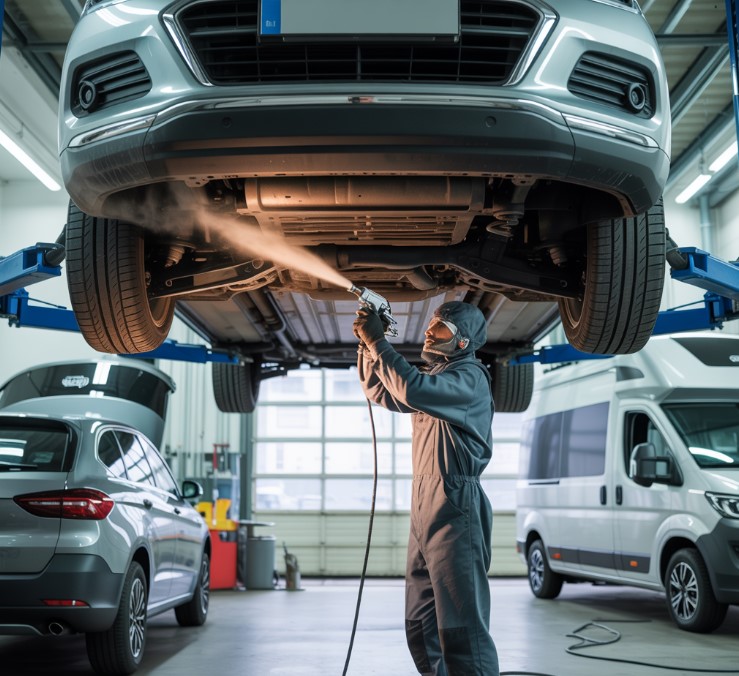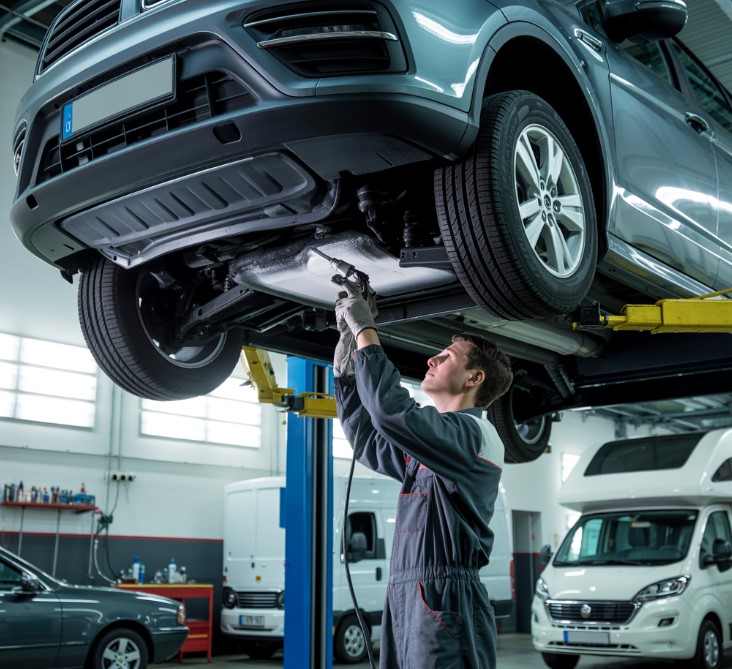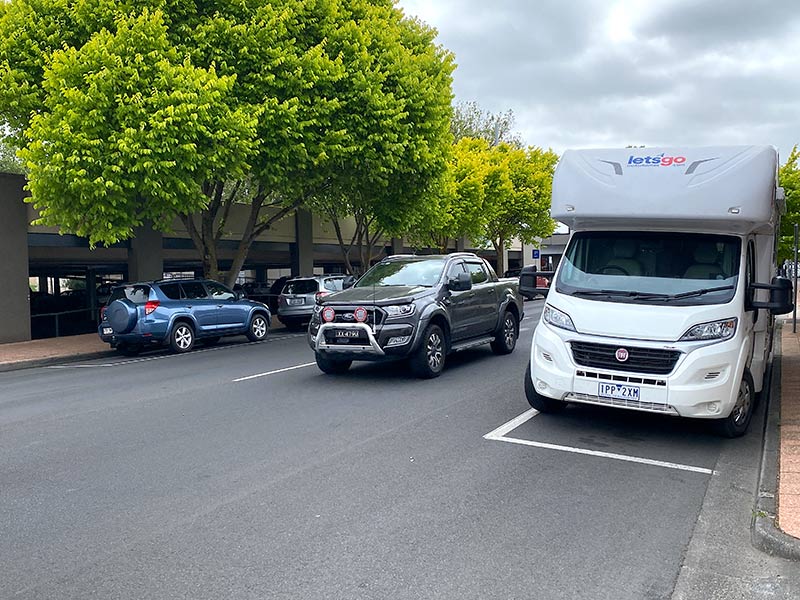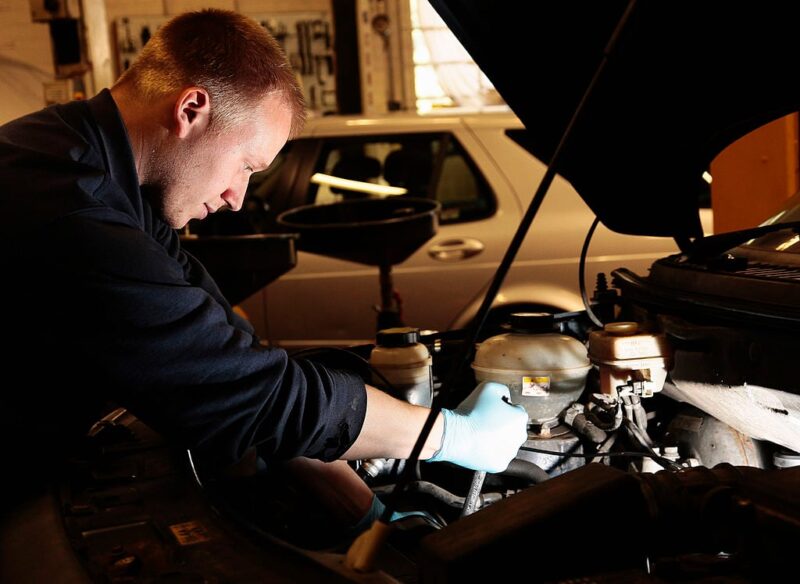Most people worry about their engine failing long before they worry about the chassis rusting away beneath them. But anyone who has kept a car, a van, or a big motorhome for more than a few winters knows the truth: metal always loses when moisture, salt, and time start attacking from below. The most honest and useful answer upfront is simple.
Undersealing is the single cheapest and most effective way to extend the life of your vehicle’s structure, especially if you live where roads get salted, seasons are wet, or the air carries a lot of humidity. You can service your engine forever, but if the underside fails, the vehicle becomes unsafe long before the mileage suggests it should.
Why Undersealing Matters More Than Most Drivers Realize

Rust does not start loudly. It begins as a quiet brown film that most people ignore during the first autumn. By the second winter, it flakes. By the third, it spreads. The underside of a vehicle is constantly exposed to water spray, gravel impacts, salt residue, and trapped moisture inside small seams and hidden channels. Even brand-new vehicles develop surface rust on unprotected areas within their first winter if they are driven in northern or coastal climates.
A simple timeline shows how fast untreated metal deteriorates:
| Exposure Condition | Timeframe | Expected Effect |
| Moisture on bare metal | Several days | First oxidation spots appear |
| Salted roads | Weeks | Rapid acceleration of corrosion |
| Two untreated winters | 1–2 years | Rust begins eating through seams and brackets |
| Continuous exposure | 4–6 years | Structural components weaken and fail |
Drivers normally only react when they hear the phrase, “This part cannot pass inspection anymore.” The damage at that stage is already expensive and often irreversible.
How Undersealing Actually Protects the Vehicle

The idea behind undersealing is simple, but the way it works is surprisingly effective. A proper underseal adds a thick, flexible, protective layer on the underside of the vehicle. This layer blocks oxygen from reaching bare metal, prevents moisture and salt from sitting directly on steel, and absorbs the impact of gravel that would normally chip away factory protection. Underseal products are designed to stick to metal even during temperature swings, vibration, and road spray.
Modern underseal coatings often include rust-inhibiting chemicals, rubberized or bitumen-based textures for durability, and formulas that remain slightly flexible so they can self-heal tiny scratches. When applied correctly, this barrier becomes a long-term shield that keeps the underside intact for years.
Types of Underseal and Their Best Use Cases
There is no single universal underseal. The correct product depends on the vehicle’s size, use, and environment. Instead of listing them as dry bullet points, this table explains where each type truly fits in real life:
| Underseal Type | Ideal Use | Longevity | Strengths | Limitations |
| Wax-based | Internal cavities, door sills, frame rails | 1–3 years | Excellent penetration; ideal for hidden areas | Needs more frequent renewal |
| Rubberized | Daily-driving cars, city vehicles | 3–6 years | Reduces noise; flexible; good overall protection | Harder to remove when reapplying |
| Bitumen-based | Vans, older vehicles, harsh winters | 5–10 years | Very tough; handles gravel and salt well | Can crack if applied poorly or unevenly |
| Polyurethane | Motorhomes, off-road vans, heavy-duty use | 6–10+ years | Extremely durable; high-strength coating | Higher cost; requires professional application |
Choosing the right type matters. A small hatchback that only drives in the city does not need the same protection as a 3.5-ton motorhome that spends every weekend in wet campgrounds. Meanwhile, vans used for work often need heavier, more impact-resistant coatings because they collect far more debris from the road.
Cars, Vans, and Motorhomes: Why the Process Is Different for Each
Although the goal is the same—protecting steel from rust—the areas that need attention vary between vehicle types.
Cars have compact underbodies with thinner metal and exposed suspension components. They benefit most from rubberized coatings that help with road noise and general protection. Vans require stronger layers because of longer wheelbases, deeper sills, and more exposed structural seams. Motorhomes, on the other hand, are essentially rolling houses: they include tank mounts, plumbing, mixed metal structures, and sometimes even wood underfloor elements. They need a flexible yet highly durable underseal that does not trap moisture.
A motorhome also stays parked for long periods, which means moisture can linger underneath for weeks. This alone makes a stronger, breathable coating a necessity rather than an option.
When You Should Consider Undersealing
Rust gives off early warnings, but you have to know where to look. Most people spot it only when the flakes fall off at the mechanic. The more you drive in winter or near the sea, the faster rust appears.
The first signs usually include small orange patches on seams, brackets, and suspension parts. Peeling factory coating is also a red flag. When the rust becomes flaky and powdery, it is already active and spreading. At that stage, undersealing still helps, but only after proper removal and treatment of the existing corrosion.
This is where many people turn to professional services because a specialist can identify which rust is superficial and which is structural.
What a Proper Professional Underseal Looks Like
A real undersealing job is much more than someone spraying black paint underneath your car. The process involves cleaning, rust removal, chemical treatment, masking sensitive parts, and applying the correct type of underseal in controlled layers.
Here is a clear look at the full process:
| Stage | What Happens | Why It Matters |
| Deep wash and degreasing | Pressure washing with detergents | The coating cannot adhere to dirt or oil |
| Mechanical rust removal | Wire brushing, grinding, sanding | Removes loose corrosion and exposes solid metal |
| Chemical rust conversion | Application of rust-neutralizing compounds | Stabilizes any remaining oxidized metal |
| Masking and protection | Exhaust, sensors, and belts covered | Prevents accidental damage and overspray |
| Application of coating | Uniform, controlled layers | Creates the long-term protective shield |
| Cavity wax treatment | Injected into sills and frame rails | Stops rust from forming inside hidden channels |
| Curing period | A few hours to overnight | Ensures the coating bonds properly |
This is why quick “spray-only” jobs last one season at best. The preparation is what determines the lifespan of the underseal—not just the coating itself.
Cost Expectations: Cars vs Vans vs Motorhomes

The price depends heavily on the size of the vehicle, the type of coating used, and the amount of rust that must be removed beforehand. Larger vehicles have more surface area and more complicated structures that require extra time and materials.
Here is a realistic breakdown for 2025:
| Vehicle Type | Light Prep (Newer Vehicle) | Medium Prep (Some Rust) | Heavy Prep (Extensive Rust) |
| Small Car | 120–250 EUR | 250–400 EUR | 400–700 EUR |
| Van | 200–350 EUR | 350–550 EUR | 550–900 EUR |
| Motorhome | 300–500 EUR | 500–900 EUR | 900–1500 EUR |
Drivers often hesitate because of the upfront cost, but when you compare it to structural repairs, subframe replacements, or welding, undersealing is significantly cheaper in the long run.
How Long Does Good Undersealing Last
The average lifespan depends on climate, mileage, and the type of underseal applied. Cars typically stay protected for 3 to 6 years. Vans that handle rougher roads usually fall into the 5-to-8-year range. Motorhomes, because of thicker coatings, can easily last 6 to 10 years with regular inspection. The key is checking the coating once a year, ideally before winter, to catch any damaged patches early.
DIY vs Professional: The Real Difference
Do-it-yourself kits exist, but they rarely work long-term unless the vehicle is nearly new and you have access to proper equipment. The biggest challenge is preparation. Most DIY jobs fail because people apply the coating over old dirt, rust, or oil residue. This traps moisture underneath, which accelerates the problem.
Professional undersealing makes more sense for older vehicles, vans, motorhomes, or anything that already shows signs of corrosion. This is why many drivers prefer mobile services that come directly to their driveway. Searching terms such as undersealing car often leads people to providers, which offer full inspection, rust treatment, and coating without needing to leave your home.
Final Thoughts
Undersealing is not a cosmetic upgrade; it is structural insurance. Cars, vans, and motorhomes face constant exposure to moisture, salt, and debris, and the metal beneath them has no way to defend itself without help. A proper underseal prevents small rust spots from becoming expensive structural problems, and for vehicles meant to last many years, it is one of the smartest investments you can make.
In a world where new vehicles cost more every year and metal thickness keeps decreasing, protecting the underside has become more important than ever. Whether you drive a compact hatchback, a work van, or a large motorhome, undersealing is often the difference between a vehicle that ages gracefully and one that rusts into retirement long before its engine gives up.








